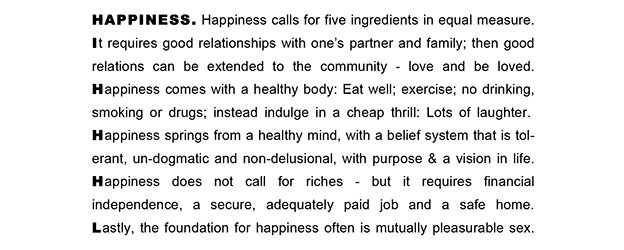916 Trying to find happiness?
What makes us happy? The quick answer is ... good relationships, health, a great job and financial independence. Some
will say a new pair of shoes or a new dress, others will be happy when they get
that new car. I have an essay HAPPINESS video in my book with three definitions of the term en.light.en.ment for a title.

Now there is a study - from Latin America - that points to a
measure of happiness that most of us know about, at least
subconsciously: High happiness is
explained by the abundance of family warmth and other supportive social
relationships frequently sidelined in favour of an emphasis on income and material success.

Trying to find happiness?
The Latin
Americans have the secret
By Jessica Irvine, SMH
If you want to know where the happiest
people in the world live - the ones who experience the greatest thrills of daily
enjoyment and elation - we must look to Latin America.
The United Nations Sustainable
Development Solutions Network released a study, the World Happiness Report.
It looks at the seemingly mysterious
phenomenon of why Latin Americans report the highest levels of “positive
affect”.
In contrast to life satisfaction,
measures of human “affect” - either positive or negative - measure the
frequency with which people experience different human sensations, emotions or
sentiments.
According to the study, Latin Americans
top the chart for the frequency with which they experience positive affect, namely
the extent to which people experience: “smile or laugh”, “learnt something”,
“treated with respect”, “experienced enjoyment” and “felt well-rested”.
The land-locked and swamp-ridden central
South American nation of Paraguay emerges as the world capital of positive
emotion, followed by Panama, Costa Rica, Venezuela and El Salvador. You have to
get to No. 9 in the list before you hit a non Latin American country - Canada,
followed by the Philippines.
It’s important to note that Latin
Americans aren’t happy all the time. They also report above average levels of
negative affect: including experiencing worry, sadness, anger, stress and
depression.
The crime, corruption and inequality that
are rife in Latin America take their toll. It’s just that the locals seem to
have found ways to also experience high levels of daily happiness, despite
their economic circumstances.
Indeed, they experience levels of
“positive affect” far above what would be predicted by their life circumstances
as measured on traditional measures, like income.
So, what is it? What is the secret ingredient
to explain the Latin American happiness miracle?
While there are 650 million people in
Latin America, there is a common Latin American culture that is unique in the
world, born of a clash of cultures: that of the Spanish and
Portuguese conquerors and local indigenous cultures which valued, predominantly,
a “coexistence with - rather than dominance of - nature”.
This leads to a society that has a slower
pace of life and that is not so focused on transforming and mastering nature
and in generating economic growth as it is in living and enjoying life within
the existing conditions. In addition, the extended-family values of the
conquerors blended with the communitarian values of indigenous groups - where
relatives tended to live together and to be in close contact.
Latin Americans are
more likely to be in close contact with family and friends.
High happiness in Latin America is
neither an anomaly nor an oddity. It is explained by the abundance of family
warmth and other supportive social relationships frequently sidelined in favour
of an emphasis on income measures in the development discourse.
So, as many (Westeners) prepare to return
to work after the long weekend, to secure the income needed to secure deeper
“life satisfaction”, we should pause and savour the simpler and more
direct pleasures of life: spending time with family and friends.